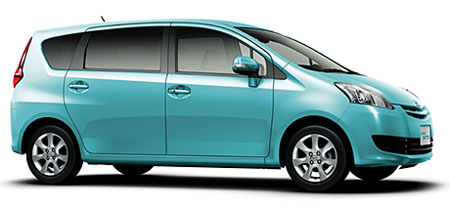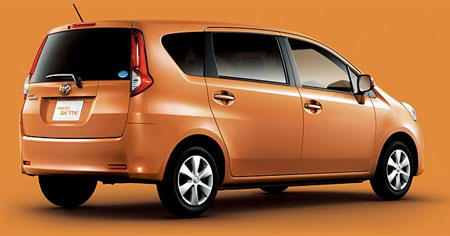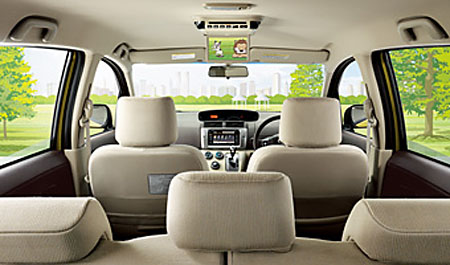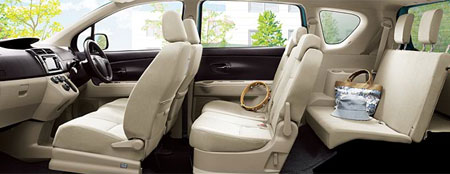Perodua MPV (D46T) to sell for RM66k and below!

As Proton gears up for its Proton Exora MPV to be launched next week, our other national carmaker Perodua is also prepping up its Perodua MPV, set to be launched in Q3 this year. The new Perodua MPV is internally called the Perodua D46T codename and is expected to be priced between RM57K to RM66k, according to Perodua MD Datuk Syed Hafiz Syed Abu Bakar in Bernama.
The new Perodua D46T will be based on the Toyota Passo Sette, also known as the Daihatsu Boon Luminas. It measures 4,180mm long, 1,695mm wide and 1,620mm tall, with a long 2,750mm wheelbase to maximize the interior space (2,550mm long).

It sits 6 or 7, depending on how big the people are, but the intention is 7 of course, because some of the Japanese model pix shows 3 headrests for the 2nd row. The same Bernama report also confirmed it will come with a 1.5 liter engine, likely the 3SZ-VE in transverse-mounted front wheel drive configuration.
There has been an interesting video that’s surfaced on Youtube, but it could be removed soon. Watch it! Also, please read the link below to find out more about the Toyota/Daihatsu car that the Perodua D46T will be based on.
Related Posts:
Toyota Passo Sette 7-seater MPV: full details!
Click here to read the rest of Perodua MPV (D46T) to sell for RM66k and below!

Toyota Passo Sette 7-seater MPV: full details!

Toyota’s latest compact 7-seater MPV has been unveiled in Japan on Christmas day, so let’s check out the full details of the new compact people carrier that will make its way onto Malaysian shores sometime in the second half of 2009 as the new Perodua MPV.
As with alot of other Toyota compact cars, the new MPV is available under both the Toyota and Daihatsu badges as compact cars like these are pretty much mainly Daihatsu-engineered as it is their speciality.
 The Toyota version is called the Toyota Passo Sette, which essentially means Passo Seven, or a 7-seater version of the Toyota Passo. Sette means seven in Italian. The Daihatsu version is called the Daihatsu Boon Luminas, where Luminas is a combination of the words roomy and luminous.
The Toyota version is called the Toyota Passo Sette, which essentially means Passo Seven, or a 7-seater version of the Toyota Passo. Sette means seven in Italian. The Daihatsu version is called the Daihatsu Boon Luminas, where Luminas is a combination of the words roomy and luminous.
All variants of the Passo Sette and the Boon Luminas are powered by the 1.5 liter 3SZ-VE engine putting out 109 PS at 6,000rpm and 141Nm of torque at 4,400rpm. Both front wheel drive and 4WD variants use a 4-speed auto, and the front wheel drive version is rated at 15.6km per liter under the 10-15 Japanese test cycle. There is an Eco-Drive indicator light on the dashboard to inform the driver when his driving style is economical.

As previously reported, the compact Toyota Passo Sette measures 4,180mm long, 1,695mm wide and 1,620mm tall, with a long 2,750mm wheelbase to maximize the interior space which is 2,550mm long. The Boon Luminas CX with a bodykit is slightly longer at 4,195mm. Other dimensions that Toyota has provided include a 1,630mm space between the front and rear seat rows, a 150mm split seat slide for the middle row, a wide 935mm rear door opening to ease getting in and out, and a 630mm hip point for the driver to also aide ingress and egress.
Despite the car’s relatively long wheelbase its wheels are at the edges of the vehicle so it is compact and it has a 5.2m turning radius.
Toyota has provided the Toyota Passo Sette with some nice features in the interior including a rear seat entertainment system with a 7 inch widescreen monitor, a DVD player with headphone outputs, and the ability to play different media in the front and rear entertainment systems. There is an optional keyless entry and start with a key fob.

The Boon Luminas also comes standard with a “music server”, which essentially lets you rip 660 minutes of audio content from your audio CDs and store it onto the car’s on-board entertainment system so you don’t have to carry your CDs around in your car. This is also a specifiable option for the Toyota Passo Sette.
The Japanese specs offers some rather decent safety features, though in the interests of cost and maximizing profit I doubt all of them will make it onto the Perodua specifications. The Passo Sette and Boon Luminas has a total of 6 SRS airbags, vehicle stability control (VSC), traction control, Dynamic Support Headrests which reduce the risk of rear-end collision whiplash, and finally ABS brakes.

Now for the Japanese market prices. The Daihatsu Boon Luminas has higher specs so it is more expensive starting from 1,535,000 yen all the way up to 2,073,000 yen, while the lower spec Toyota Passo Sette starts from 1,490,000 yen but can be fully loaded up to a maximum price of 2,033,000 yen.
Please continue reading for a whole load of more photos and videos! It will give you a rough idea of the car to expect next year from Perodua.
Click here to read the rest of Toyota Passo Sette 7-seater MPV: full details!
New Toyota Passo Sette / Daihatsu Boon Ruminous 7-seater MPV to make Christmas 2008 debut!
LATEST UPDATE: Toyota Passo Sette 7-seater MPV - full details!
Toyota and Daihatsu have called for a joint press conference in Japan on Christmas day to unveil their latest 7-seater compact MPV, strongly believed to be named the Toyota Passo Sette and the Daihatsu Boon Ruminous. After the car’s public unveiling this month, it will go on sale early next year about the same time as Proton is expected to launch its MPV, which could pose a problem for Proton as potential customers in Malaysia would be able to get a preview of this new MPV that will hit Malaysian roads as a Perodua in Q3 2009, just half a year after the Proton MPV is launched.
Still, the two vehicles are not exactly in the same segment. This new Toyota/Daihatsu/Perodua MPV is smaller than the Proton MPV. However because is primarily a Daihatsu product, it inherits the Japanese K-car’s expertise in squeezing the most space into the smallest package. The engine under the hood will be the 3SZ-VE 1.5 liter that’s found in the Toyota Avanza, but installed transversely instead of longitudinally and powering the front wheels instead of the rear wheels.
| Dimensions | New MPV | Sienta | Wish | Freed | Myvi F/L |
| Length | 4180mm | 4100mm | 4650mm | 4215mm | 3750mm |
| Width | 1695mm | 1695mm | 1745mm | 1695mm | 1665mm |
| Height | 1620mm | 1670mm | 1600mm | 1715mm | 1550mm |
| Wheelbase | 2750mm | 2700mm | 2750mm | 2740mm | 2440mm |
(dimension comparison table from my previous post)
Given how many Malaysians think long and hard between the Persona and the Myvi as if they were in the same segment when they are actually not because of similiar pricing, this new Perodua MPV could pose a real threat to the new Proton MPV for those who just must have a “Toyota”, whether with a Perodua badge or not.
An indicated price for the Japanese market car is between 1.45 million yen to 1.8 million yen, which is about RM57k to RM70k, so that should give you guys an idea how much a localised version would cost. Don’t expect things like the column shifter you see in the brochure above to make it into the Perodua version as the Passo also had that but it got switched to a traditional shifter between the seats for the Myvi.
Whether you want to call it the new Toyota Passo Sette, or the Daihatsu Boon Ruminous, or the 2009 Perodua MPV, you can check out interior photos and a side profile which have been revealed in the brochure above, which does not mention the vehicle’s name yet. Or for more details, check out the related links listed below.
Related Posts:
2009 Perodua MPV Artist’s Impression
New Toyota MPV: details of the new 3-row compact MPV that Perodua will also build
New Perodua MPV coming in September 2009
2009 Perodua MPV: new artist’s impression
This is an artist’s impression of the upcoming Perodua MPV that is set to be released in Q3 2009. Theophilus Chin’s rendering is based on the upcoming Toyota-Daihatsu compact MPV project that is set to be launched in Indonesia in early 2009. The Malaysian launch will come soon after.
Theophilus has given the Perodua version of the new Toyota compact MPV an aggressive front bumper inspired by the front bumper of the Daihatsu Sirion Sport. The bulging nature of the front bumper’s wheel arches are to complement the slightly bulging rear wheel arch that the Toyota version has. The grille has hints of the new Hyundai i-series grille in it while the headlamps are inspired by the JDM Toyota Camry.
And there’s of course the Perodua badge. This is probably much more accurate than the random impression posted here some time ago.

Toyota’s new compact MPV set for a 2009 debut
As a recap, here is a table comparing the dimensions of the new Toyota MPV versus some other MPVs available in our market, as well as competing MPVs from other manufacturers.
| Dimensions | New MPV | Sienta | Wish | Freed | Myvi F/L |
| Length | 4180mm | 4100mm | 4650mm | 4215mm | 3750mm |
| Width | 1695mm | 1695mm | 1745mm | 1695mm | 1665mm |
| Height | 1620mm | 1670mm | 1600mm | 1715mm | 1550mm |
| Wheelbase | 2750mm | 2700mm | 2750mm | 2740mm | 2440mm |
For more details on this new compact MPV, visit the related links.
Related Links:
New Toyota MPV: details of the new 3-row compact MPV that Perodua will also build!
New Toyota MPV: details of the new 3-row compact that Perodua will also build!

Left: Artist’s rendering, Top-right: Mag-X thumbnails
We finally have some pretty solid but unofficial details on the upcoming compact 3-row MPV that Toyota and Daihatsu have been working on, scheduled to be launched next year. This is also the same vehicle that will be the base of the new Perodua MPV to be launched in Q3 of 2009, just in time for Hari Raya.
The word is that the Toyota version will be called the Toyota Passo Sette while the Daihatsu version will be called the Daihatsu Boon Ruminous, and will cost between 1,380,000 yen to 1,880,000 yen in Japan.
The Toyota version has a front end and headlamps that are very similiar to the current generation Toyota Vios. In classic Toyota style in knowing exactly how some Japanese love individuality and customization, the Japanese version will also get an alternate front end that is more sporty and aggressive. The Perodua version will naturally have its own front end, with a new grille, bumper and headlamps.
Toyota also has an existing compact 3-row MPV called the Toyota Sienta so it would be fair to compare this new MPV to the Sienta, and also the Passo/Boon/Myvi. And why not throw in the new Honda Freed into the mix. Let’s have a look:
| Dimensions | New MPV | Sienta | Wish | Freed | Myvi F/L |
| Length | 4180mm | 4100mm | 4650mm | 4215mm | 3750mm |
| Width | 1695mm | 1695mm | 1745mm | 1695mm | 1665mm |
| Height | 1620mm | 1670mm | 1600mm | 1715mm | 1550mm |
| Wheelbase | 2750mm | 2700mm | 2750mm | 2740mm | 2440mm |
From the table above we can see that the new MPV is wider as well as longer in both length and wheelbase compared to the Sienta and the Myvi. A 2750mm wheelbase is impressive - that’s as long as the Subaru Exiga, which is quite a big vehicle!
It’s also quite obvious from even photos that the new Perodua MPV will be between the Sienta and the Myvi in terms of height as the Sienta is quite tall, but this new MPV loses some of that height for a sleeker profile that is generally more acceptable outside of Japan. After all, Indonesia is expected to be a production center for the car in ASEAN.
Something also very interesting is the fact that it is equal to the Wish in terms of wheelbase but significantly shorter and also narrower. Another key difference between this new MPV and the Toyota Sienta is the fact that the Sienta has sliding doors for the rear doors while this car uses conventional swing doors.
The primary engine for the Japanese market will be the 1.5 liter 3SZ-VE producing 109 PS at 6,000rpm and 141Nm of torque, but a 1.3 liter version could be available for the ASEAN market since the Avanza 1.3 was accepted quite well here.
The Japanese market interior will feature a dashboard with a centrally-mounted speedo and also a dash-mounted shifter (CVT for FWD, 4-speed auto for 4WD). ASEAN versions could see this shift lever moved to the area between the seats instead as we’ve seen this happen before with the Myvi (Passo) and the Nautica (Terios).
 From the Toyota product photos of the interior leaked by MagX, the second row looks like it can either fit 3 adults but I think 2 adults and 1 child would be more comfortable. At least it comes with 3 headrests, though this may be omitted in our market for cost cutting. The third row is a strict 2-seater.
From the Toyota product photos of the interior leaked by MagX, the second row looks like it can either fit 3 adults but I think 2 adults and 1 child would be more comfortable. At least it comes with 3 headrests, though this may be omitted in our market for cost cutting. The third row is a strict 2-seater.
The second and third row can be folded down for a flat loading area. The loading area is 1330mm wide at the rear-most area but when you fold down the rear seats, this width reduces to 1045mm because of the rear wheel arches protruding into the cabin. The loading area height is 858mm.
So, there you have it. There’s no telling at the moment which market will get the new Toyota compact MPV first, but it’s either between one of the ASEAN countries (Indonesia in particular), or Japan. One possible unveiling schedule could see a more “sophisticated” (dash-mounted shifter, option for DVD player, etc) Japan version unveiled first, then a low cost ASEAN version, and finally the Perodua version in Q3 2009.
Look after the jump for one more side profile shot of the new Toyota/Daihatsu/Perodua 3-row compact MPV.
2009 Perodua MPV Rendered Speculation
The upcoming Perodua MPV is still pretty far off, set to roll off the production lines only in September 2009, but here is a rendered speculation by Theophilus Chin of how it will might look like. Based on an existing Toyota compact MPV, the styling for this three row MPV rendering is largely based off the Perodua Viva.
Perodua CEO Datuk Hafiz mentioned in an interview with The Edge Weekly earlier this year that we should think of the new Perodua MPV as a smaller Toyota Wish that will have three rows and sit 6 people comfortably (probably not 7 because of a Perodua’s typically compact size and thus reduced width).
It will be based on the recently announced new Indonesian-based MPV model that was announced in March this year and is currently still under development by Toyota and Daihatsu. Perodua will apply its own styling onto the model.
Look after the jump for a rear shot of Theophilus Chin’s rendering as well as some other photoshop “experiments”. PS: KSG = Kenderaan Serba Guna.
Click here to read the rest of 2009 Perodua MPV Rendered Speculation
Ingress gets Perodua MPV supply contract
 Ingress Technologies Sdn Bhd was recently awarded the contract for the supply of 6 modules for a new Perodua model, which includes the reinforcement roof child part, door child part, rocker panel assembly, fuel lid assembly, lower back assembly and under rear sub-assembly. This will make ITSB a Tier-1 supplier.
Ingress Technologies Sdn Bhd was recently awarded the contract for the supply of 6 modules for a new Perodua model, which includes the reinforcement roof child part, door child part, rocker panel assembly, fuel lid assembly, lower back assembly and under rear sub-assembly. This will make ITSB a Tier-1 supplier.
Supply will start in the third quarter of the financial year ending January 31 2010. As this would mean sometime in the second half of 2009, this news confirms the circa-September 2009 launch date of the new Perodua MPV mentioned recently by Perodua head Datuk Hafiz.
Related Posts:
New Perodua MPV coming in September 2009
New Perodua MPV coming in September 2009

Click image above more details on the car that the Perodua MPV will be based on
 UPDATE: The new Toyota MPV that the Perodua MPV will be based on has been unveiled! Click the linked text to find out how the new MPV looks like as well as its dimensions and specifications.
UPDATE: The new Toyota MPV that the Perodua MPV will be based on has been unveiled! Click the linked text to find out how the new MPV looks like as well as its dimensions and specifications.
An interview with Perodua managing director Datuk Hafiz Syed Abu Bakar in The Edge Weekly has revealed some plans about Perodua this year. For one, Perodua will be undergoing a rebranding sometime in the middle of the year, which will coincide with the launch of the new Perodua Kembara. The rebranding exercise will also give Perodua a new logo, which will be more of a restyled evolution of the current one rather than something new.
The new Perodua Kembara will come with a 1.5 liter engine (likely the 3SZ-VE) and will have four-wheel drive. It will not be assembled locally by Perodua but will be a CBU import from Japan. It will be a low volume product, and the expected price tag is likely to be more than the Toyota Rush because of its higher specs (the 4WD drivetrain) and Japan sourcing. It will be targetted at the urban, upper-middle income group. Expect the new Perodua Kembara to be based on the short wheel base Daihatsu Terios with a May 2008 launch date.
Another surprise revealed in the article is Perodua’s plans for 2009. Perodua will launch a new three row 6-seater MPV in September 2009. Datuk Hafiz likened it to a Toyota Wish, but a smaller version. I wonder what could this be based on. Can’t really think of any compact 6-seaters from Daihatsu/Toyota other than the Daihatsu Gran Max, but that’s more of a Rusa-like van.
If you read this article by Xinhua News Agency posted on the 5th of March 2008. it is revealed that Toyota and Daihatsu is developing a new MPV in Indonesia. The MPV is set to be launched in 2009. This model is could be the one that the new 2009 Perodua MPV will be based on.
Anyway whatever it is, it’s something to look forward to next year. 2009 seems to be the year of the MPVs.



No comments:
Post a Comment